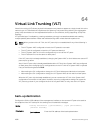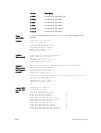
Version Description
9.0.2.0 Introduced on the S6000.
9.0.0.0 Introduced on the Z9000.
8.3.19.0 Introduced on the S4820T.
8.3.12.0 Added port-channel parameter on the S4810.
8.3.8.0 Introduced on the S4810.
Usage
Information
LACP on the VLT ports (on a VLT switch or access device), which are members of
the virtual link trunk, is not brought up until the VLT domain is recognized on the
access device.
On the S4810, during boot-up in a stacking configuration, the system must be able
to reach the DHCP server with the boot image and configuration image. During
boot-up, only untagged DHCP requests are sent to the DHCP server to receive an
offer on static LAGs between switches. The DHCP server must be configured to
start in BMP mode. If switches are connected using LACP port-channels like the
VLT peer and Top of Rack (ToR), use the port-channel parameter on the ToR-side
configuration to allow member ports of an ungrouped LACP port-channel to
inherit vlan membership of that port channel to ensure untagged packets that are
sent by a VLT peer device reach the DHCP server located on the ToR.
To ungroup the VLT and port-channel configurations, use the no lacp ungroup
member independent command on a VLT port channel, depending on whether
the port channel is VLT or non-VLT.
Example
Dell(conf)#lacp ungroup member-independent ?
port-channel LACP port-channel members become
switchports
vlt All VLT LACP members
become switchports
multicast peer-routing timeout
Configure the time for a VLT node to retain synced multicast routes or synced multicast outgoing
interface (OIF) after a VLT peer node failure.
Syntax
multicast peer-routing timeout value
To restore the default value, use the no multicast peer-routing timeout
command.
Parameters
value Enter the timeout value in seconds. The range is from 1 to
1200. The default is 150.
Virtual Link Trunking (VLT)
1847


















